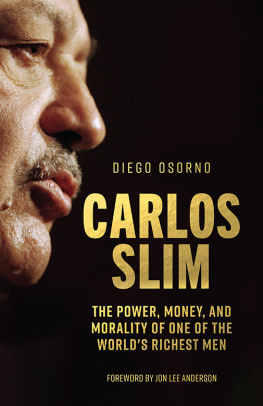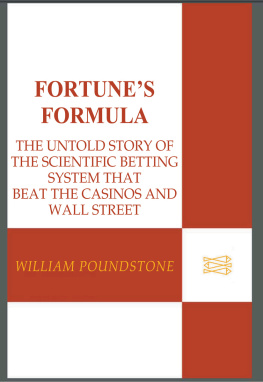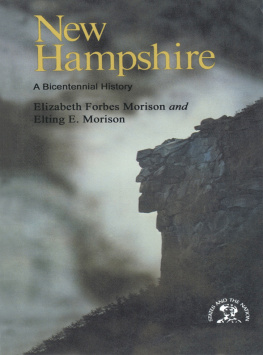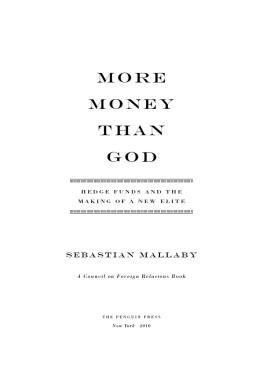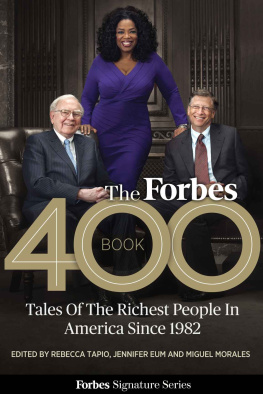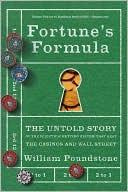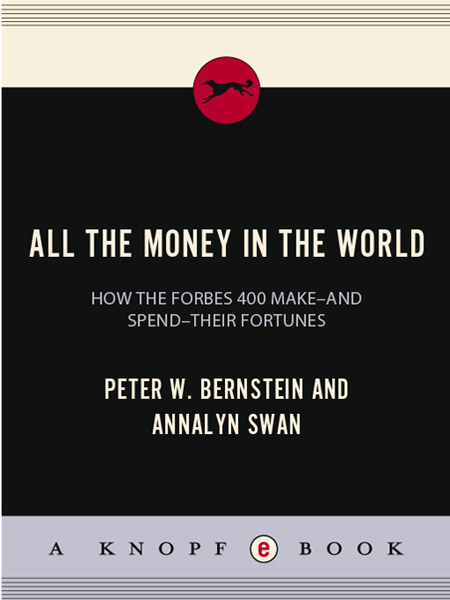

Contents
Acknowledgments
For the past twenty-five years, Forbes magazine has compiled its now legendary list of the four hundred wealthiest Americans and considered the state of the nations vast fortunes. Its issues on the subject have been rich in facts and figures, on whos up and whos down, on whether Bill Gates (or Donald Trump) has a billion more or less. But the list is perforce numbers-driven; the issues focus less on the character of the people and the peculiar world they inhabit. What makes the Forbes 400 members tick? Who gets to the topand why? How different are they from more average Americans? Are they happy? What lessons about money and life can we glean from them?
In All the Money in the World: How the Forbes 400 Makeand SpendTheir Fortunes, we set out to answer these questions and to create a collective profile of Americas superrich over twenty-five years. While this book was created in collaboration with Forbes, much of the information comes from our own interviews, original research, and never-before-compiled data.
When we first approached Tim Forbes, the companys chief operating officer, with the idea for the book, he enthusiastically endorsed it. Throughout the research and writing, many at the magazine eased our way, sharing insights, opening archives and files, providing phone numbers and e-mail addresses, and helping in every way possible. Pete Newcomb, the longtime editor of the Forbes 400 list, was an inexhaustible source of information about members of the 400, as was his successor, Matthew Miller. James Michaels, the first editor of the Forbes 400, shared with us information, anecdotes, and insights from the early years. Additionally, Mitchell Rand, director of information technology, provided original and insightful analysis of Forbes 400 data over the last twenty-five years, while Barbara Strauch, director of Forbess book division, reviewed the data and manuscript and compiled the definitive list of all Forbes 400 members. Their efforts are immediately evident in the many charts, graphs, and tables throughout the book, to which designer Nigel Holmes has brought his distinctive flair.
At the heart of All the Money in the World are the voices of the Forbes 400 members themselves, as well as those of their families. Many gave us extensive interviews. (A few requested anonymity; we honored their wishes.) Others respondedsometimes at lengthto a questionnaire we sent. Still others maintained an e-mail correspondence with us. We are most grateful to them for their time and insights into every aspect of Forbes 400 careers, philanthropic causes, and much more: Sheldon Adelson, John E. Anderson, Leon Black, Timothy Blixseth, Michael Bloomberg, Eli Broad, Peter Buffett, Susie Buffett, S. Truett Cathy, Jim Clark, Mark Cuban, David Duffield, Red Emmerson, Ken Fisher, Ted Forstmann, Daniel Gilbert, David Gold, Stanley S. Hubbard, J. B. Hunt, Jon Huntsman Jr., Michael Huffington, Wayne Huizenga, David Kaplan, Vinod Khosla, Charles Koch, David Koch, Jerome Kohlberg, Herbert Kohler Jr., Bruce Kovner, Ronald Lauder, John Malone, Ross Perot, Ross Perot Jr., T. Boone Pickens, Marc Rich, Julian Robertson, Arthur Rock, Wilbur L. Ross, Richard Mellon Scaife, Charles Schwab, Steve Schwarzman, Charles Simonyi, Ram Shriram, Robert F. X. Sillerman, John Sobrato, James Tisch, Donald Trump, Ivanka Trump, Mortimer Zuckerman.
This book has also benefited greatly from the wisdom of many writers, professors, and analysts who have thought and written about wealth. Each is credited in the Notes section, at the top of the chapters in which they are quoted. We owe a number of them special thanks: the writers Nelson W. Aldrich Jr., Ken Auletta of The New Yorker, Dr. Paul Babiak (industrial psychologist and author), Ron Chernow, Richard Conniff, Edward Jay Epstein, David A. Kaplan of Newsweek, Dr. Michael Maccoby (psychoanalyst and author), Washington Post business columnist Steven Pearlstein, Matthew Symonds of The Economist, and Thayer Cheatham Willis. A number of professors gave generously of their time and insights: Raphael Amit (Wharton School, University of Pennsylvania), Joseph Astrachan (Kennesaw State University), John C. Coffee (Columbia University Law School), Pablo Eisenberg (Public Policy Institute, Georgetown University), K. Anders Ericsson (Florida State University), Charles Geisst (Manhattan College), Alexander Horniman (Darden School of Business, University of Virginia), Christopher Jencks (Harvard University), Steven Kaplan (University of Chicago Business School), Andrew Keyt (Chicago Family Business Center, Loyola University), Josh Lerner (Harvard Business School), Anthony Mayo (director, Leadership Institute, Harvard Business School), Eli Noam (Columbia University Business School), Peter Singer (Princeton University), David A. Skeel Jr. (University of Pennsylvania), George Smith (Stern School of Business, New York University), James Allen Smith (Georgetown University), Roy C. Smith (New York University), Robert J. Sternberg (dean of the School of Arts and Sciences, Tufts University), Jonathan Taplin (Annenberg School for Communication, University of Southern California), David Waterman (Indiana University), and Jerry White (Caruth Institute of Entrepreneurship, Cox School of Business, Southern Methodist University). In many cases, they are also the authors of well-known books, which are listed in the Notes section.
A major theme of All the Money in the World is how the Forbes 400 spend their money. Many are philanthropists and have created foundations of their own. Others try to influence politics. Several people were particularly helpful in describing the universe of charitable giving and the ways in which money can buy power. William Luers, former president of the Metropolitan Museum of Art in New York and now head of the United Nations Association of the USA, was a valuable guide, as was Vartan Gregorian, president of the Carnegie Corporation. Others whose insights enrich the book included Rich Avanzino, president, Maddies Fund; Joe Breiteneicher, president, The Philanthropy Initiative; Kathy Bushkin, chief operating officer, United Nations Foundation; Chuck Collins, cofounder of Responsible Wealth; William Dietel, president, F. B. Heron and Pierson/Lovelace Foundation; Joan DiFuria and Stephen Goldbart, codirectors, Money, Meaning & Choices Institute; Sara Hamilton, of Family Office Exchange; Dr. Lee Hausner, of the family-wealth consulting firm IFF Advisors; John Healy, former president, Atlantic Philanthropies; Todd Millay, executive director, Wharton Global Family Alliance; Aryeh Neier, president of the Open Society Institute; Judith Stern Peck, director of the Money, Values and Family Life Project, Ackerman Institute for the Family; Tim Stone, president, and Ryan Nguyen, research manager, NewTithing Group; Celia Wexler, vice president for advocacy, Common Cause; and Rod Wood, Wilmington Trust.
The Beyond Wall Street chapter benefited, in particular, from the advice of experts who helped us navigate the often arcane world of high finance. We are grateful to John K. Castle, former president of famed Wall Street investment-banking firm Donaldson Lufkin & Jenrette and now chairman of Castle Harlan, for giving us the benefit of his encyclopedic knowledge of the history of Wall Street and of the various financial developments of the past twenty-five years. Also providing insight were Zachary Bagdon, executive director, International Center for Finance, Yale School of Management; Steve Drobny, cofounder and partner of Drobny Global Advisors and author of
Next page

